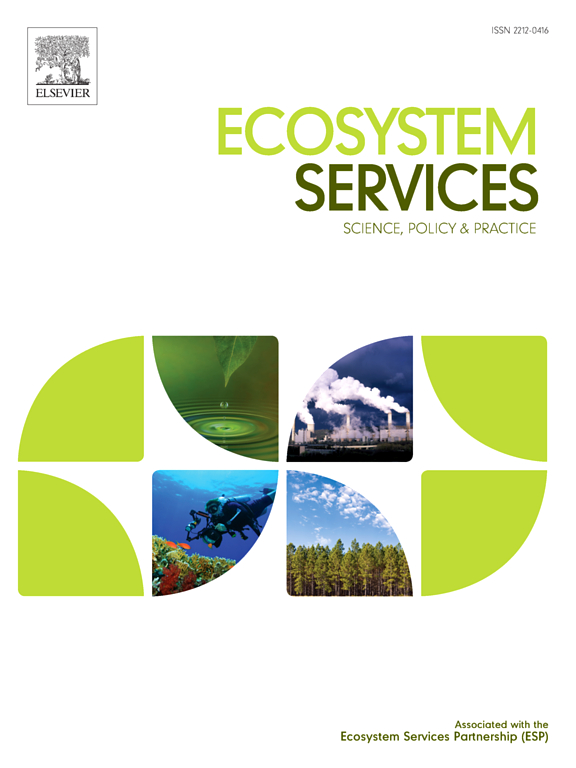Flood prevention benefits provided by Canadian natural ecosystems
IF 6.1
2区 环境科学与生态学
Q1 ECOLOGY
引用次数: 0
Abstract
The escalating impacts of climate change have heightened concerns about the frequency and severity of natural disasters, particularly extreme flooding events. Future projections underscore the necessity for innovative flood prevention strategies, including broad-scale nature-based solutions. Here, we present the first comprehensive assessment of the flood prevention benefits provided by Canadian natural ecosystems and identify key areas crucial for human well-being. Using spatially explicit modeling, we (1) evaluated the potential runoff retention by natural ecosystems and (2) identified downstream urban and agricultural areas critically dependent on these natural benefits, particularly those in floodplains and close proximity to upstream natural ecosystems. The natural ecosystems within the top 5 % of sub-basins, representing regions with a high priority for conservation practices aimed at flood prevention, play a crucial role in safeguarding approximately 54 % (∼6,000 km2) of the total built-up area and 74 % (∼16,900 km2) of the total cropland situated within floodplains. Additionally, they are positioned upstream of floodplain-based urban zones belonging to 358 population centers, directly benefiting 3.7 million people (∼10 % of the Canadian population) and indirectly benefiting almost 20.1 million people (∼56 % of the Canadian population). Moreover, among Canada’s 5.2 million km2 of flood-preventing natural ecosystems, we identified a small fraction (10 %) whose loss or degradation would result in a significant (>50 %) increase in runoff. Several of these crucial ecosystems are situated in less populated northern regions, where local governments might want to incentivize conservation initiatives to support flood prevention. Our research underscores the imperative to integrate nature-based solutions into national strategies that consider the results of spatial planning analyses. Establishing other effective area-based conservation measures in the priority regions highlighted in this study can contribute towards reaching current ambitious environmental goals and provide critical flood prevention benefits. Additionally, our methods are transferable to other regions worldwide, leveraging globally available datasets and ensuring computational feasibility.
加拿大自然生态系统提供的防洪效益
气候变化的影响不断升级,加剧了人们对自然灾害频率和严重程度的担忧,尤其是极端洪水事件。对未来的预测强调了创新防洪战略的必要性,包括基于自然的广泛解决方案。在此,我们首次对加拿大自然生态系统提供的防洪效益进行了全面评估,并确定了对人类福祉至关重要的关键领域。利用空间显式建模,我们(1)评估了自然生态系统对径流的潜在滞留作用,(2)确定了下游城市和农业区对这些自然效益的严重依赖,特别是那些位于洪泛区和靠近上游自然生态系统的地区。排名前 5%的子流域内的自然生态系统代表了以防洪为目的的保护措施的优先级较高的地区,在保护位于洪泛区内的总建筑面积的约 54%(6,000 平方公里)和总耕地面积的 74%(16,900 平方公里)方面发挥着至关重要的作用。此外,它们位于洪泛平原城市区的上游,属于 358 个人口中心,直接惠及 370 万人(占加拿大人口的 10%),间接惠及近 201 万人(占加拿大人口的 56%)。此外,在加拿大 520 万平方公里的防洪自然生态系统中,我们发现有一小部分(10%)生态系统的丧失或退化将导致径流量显著增加(50%)。这些至关重要的生态系统中有几个位于人口较少的北部地区,当地政府可能希望鼓励采取保护措施来支持防洪。我们的研究强调,将基于自然的解决方案纳入考虑空间规划分析结果的国家战略势在必行。在本研究强调的重点区域建立其他有效的区域保护措施,有助于实现当前宏伟的环境目标,并提供重要的防洪效益。此外,我们的方法可移植到全球其他地区,充分利用全球可用的数据集,确保计算的可行性。
本文章由计算机程序翻译,如有差异,请以英文原文为准。
求助全文
约1分钟内获得全文
求助全文
来源期刊

Ecosystem Services
ECOLOGYENVIRONMENTAL SCIENCES&-ENVIRONMENTAL SCIENCES
CiteScore
14.90
自引率
7.90%
发文量
109
期刊介绍:
Ecosystem Services is an international, interdisciplinary journal that is associated with the Ecosystem Services Partnership (ESP). The journal is dedicated to exploring the science, policy, and practice related to ecosystem services, which are the various ways in which ecosystems contribute to human well-being, both directly and indirectly.
Ecosystem Services contributes to the broader goal of ensuring that the benefits of ecosystems are recognized, valued, and sustainably managed for the well-being of current and future generations. The journal serves as a platform for scholars, practitioners, policymakers, and other stakeholders to share their findings and insights, fostering collaboration and innovation in the field of ecosystem services.
 求助内容:
求助内容: 应助结果提醒方式:
应助结果提醒方式:


